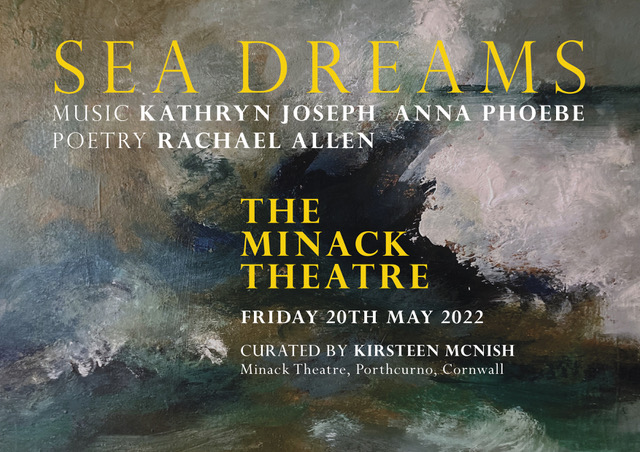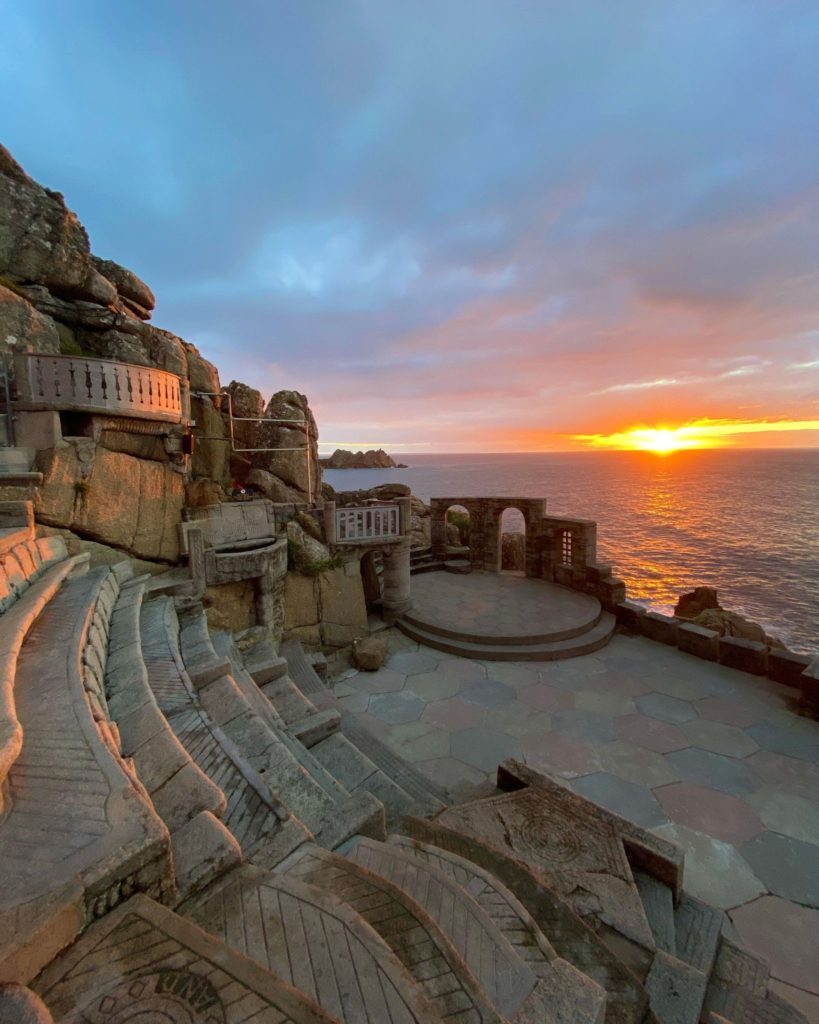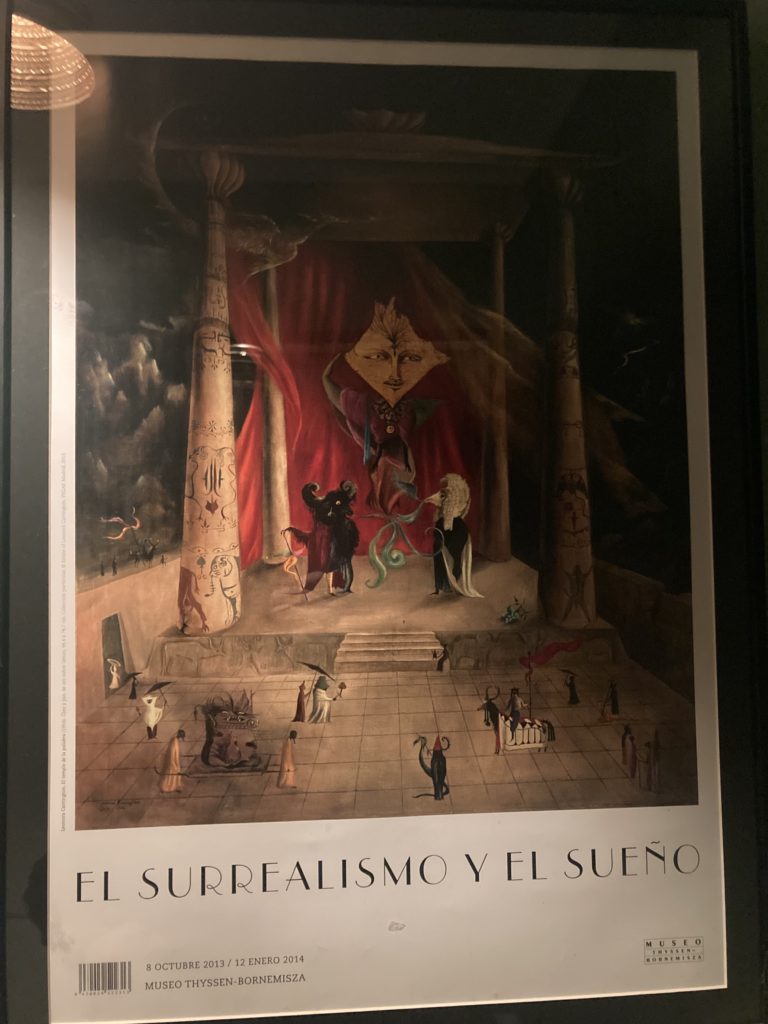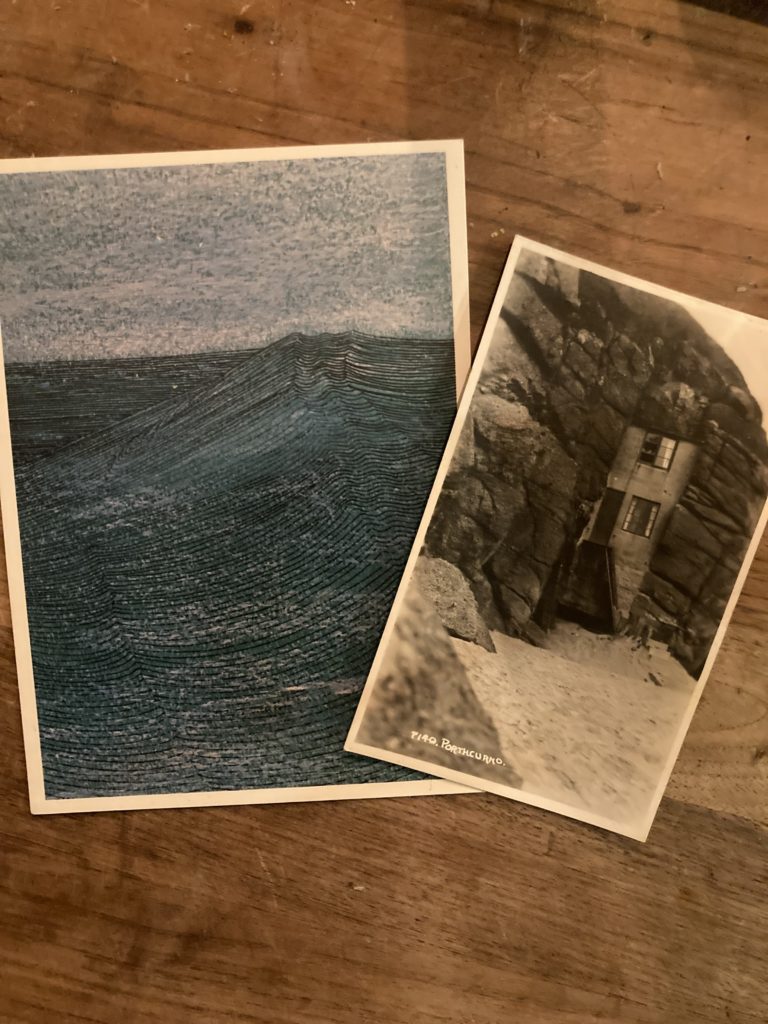Kirsteen McNish shares the inspiration behind her upcoming event at Porthcurno’s Minack Theatre.

Poster: Andrew Jackson
Last year, whilst many restrictions were in place and events were largely all off or adapted, my thoughts were preoccupied with the outer reaches of this small island we live on, which seemed exotic and largely out of reach. I pushed away thoughts of the Highlands of Scotland, the rolling hills and hedgerows of Devon and rugged contours of Cornwall as much as I pushed away thoughts of stepping inside a café or a music venue. Over many years I have programmed events in unusual settings — from forests to wetlands, galleries, to boats, churches, shops, trades clubs, cinemas and architectural institutions — but never one connected to the sea. The sea is my greatest pull, and yet as a non-swimmer, I am forever on the periphery, one foot on land and one in the ocean; beguiled by its power and yet never fully enveloped within its waves. So, I set to it, to enact an abstract dream, with artists whose work is ingrained and intertwined with the sea, land, and sky and a setting that exists on a precipice of sorts.
The Minack Theatre in Porthcurno, Cornwall was dreamt up by its visionary founder Rowena Cade. Her vision wasn’t an easy one to execute: she designed an amphitheatre-type structure, on a cliffside overlooking one of the most breath-taking views, arguably, in the whole of the UK. It was down to her indominable spirit and determination that this place exists on the cliffside and hosts (mainly) theatre seven days a week. She, with her gardener, would be out on the cliffside in all weathers, hacking into the rocks not with diggers or cranes, but hammers and chisels — and where that failed, sticks of dynamite. They lugged rocks up from the beach on ropes and pulleys and created a complex concrete structure, mixing by hand and working tirelessly. Aside from being essentially the architect of this place, a theatre producer and visionary, Rowena Cade was an artist. Evidence of this can be found in the images chiselled into each and every seat. The more I read about the Minack Theatre and its founder the more it haunted the edges of my imagination.
In June 2021, I spoke via Zoom with the Minack’s director, Zoe Curnow. Zoe beamed warmly from the camera in her office at the Minack as I sat in my house overlooking the garden on a warm day, dappled sunlight filtering through the trees whilst I excitedly outlined my intentions. I felt from both her conversation and enthusiasm that Zoe is a person who is in the business of genuinely supporting other women and their creative work, and, like Rowena Cade, works tirelessly to ensure this sacred space stays open to the public. Somehow, she found me a date in a very busy programme and we got cracking to curate something special.
On May 20th, when the moon rises high over the sea, musicians Kathryn Joseph, Anna Pheobe and poet Rachael AlIen will perform their work, old and new, in the dramatic setting of this open-air theatre. Sea Dreams is based around a creative imagining of the elements of water, air, and earth: the spaces between material and non-material worlds, imagination, dreams and elemental forces, all set against the backdrop of ocean that crashes against the rocks from which the Minack Theatre is hewn.

Photo: Lyn Batten
Living between Glasgow and the East Coast of Scotland for many years, Kathryn Joseph’s relationship to the sea helps shape her work, like the waves that leave strange indentations and ghostly marks on sea walls. Despite this setting being at the opposite end of the country to where she lives, it has long held a vivid place in her imagination. Joseph’s haunting, sparsely-boned songs are accompanied by a ship’s piano in many of her recordings, and at this event she will be welcomed on stage with the eerie echoes of the sound reverberating from the rocks, intermingled with her own emotional phantoms, as she performs work from her forthcoming album For You Who Are The Wronged, released in late Spring as the days start to shake off the shadows and the earth awakens again.
The perspectives of one of these artists’ work is intermeshed with scientific perspectives of earth from above. Multi-instrmentalist Anna Phoebe is currently collaborating with scientists from the European Space Agency, studying and interpreting earth observation data which will be threaded with ancient and ethereal voices, creating new work inspired by this oceanic location for solo violin. The piece, to be played for the first time ever at the Minack, is in part, she hopes, a wider call to action around climate change and our seas.
Poet Rachael Allen (who grew up in Cornwall nearby), will read from the arresting collection Kingdomland, which leaves the reader with a burning imprint of the inner conflict at the borderlands of womanhood and mortality. The very sea itself plays a conflicted role, oscillating between being powerfully menacing and mirror-calm and benign. Allen invites you into disquieting spaces, but lets you sit with the discomfort — there is no spoon-feeding the reader. Potent and disturbing things lie not too far beneath each line, and one has the enduring sensation that the watcher is also being watched.
While researching the setting, a triangulation of facts symbolically stood out to me, aside from my desire to work with these three brilliant artists. The location juts out 90 miles into the Atlantic ocean, 90 steps lead from the beach to the stage, and the event takes place 90 years after Rowena Cade built the theatre. The circular stage seems to symbolise the earth on its axis, the turn of the seasons and a reminder that the passing of time is crucial for the challenges we face with climate change. The performances will be purposefully stripped back because these three brilliant artists, I believe, do not need artifice. The setting is as much a part of the performance as the artists themselves, acknowledging we are just a small part of a bigger and complicated eco-system.

Within my mind’s eye whilst curating this event I am drawn back to a gallery poster of a Leonora Carrington painting in my house called The Temple Of The World. This outdoor venue also feels like a temple, or at least a sacred space where people experiment with new work and commune in a setting that exists almost in between worlds — real and imagined. Although not directly related to the Minack, I have recently been drawn to a brilliant book about Ithell Colqhoun by author Amy Hale which delves into her occultism, her relationship with this part of Cornwall and her surrealist depictions which resulted in utterly unforgettable paintings; some undoubtedly influenced by the coastline and the interplay of its landscape with human life. I have also been inspired also by a postcard entitled Ground Swell sent by an artist friend, Clare Archibald, (whose own music, collaborations, and creative work haunts and reverberates with the Fife coastline). This postcard Clare sent to help inspire me permanently sits on my kitchen table as I work, and led quickly to a deeper investigation into more of the vibrant, sculptural and energetic paintings of Wilhelmina Barns Graham, (who was Fife-born but who moved to the north coast in St Ives to create a huge body of work, despite being repeatedly told she should give up her calling).
Like Rowena Cade, through active imagining and determination, these artists of a previous generation dreamt their work into being, despite varying constraints of the era and what was expected of their gender. Their work punctured the ether and is held there, depicting one of the most powerful feminine forces of all — the sea. I trawl the web and discover more about women Cornish writers and poets online through publisher Hypatia Trust, whose work and back catalogue is well worth exploring, and I learn of new work by Natasha Carthew, who releases her recently announced Cornish memoir UNDERCURRENT — about poverty, landscape, nature and resilience — next year. I realise I am only breaking the surface of the pool and I am a mere visitor on the fringes, but I also want to take in all I can about the history of this place in the little time I can scratch out between my own work and family responsibilities.

Trawling eBay for books and ephemera, which I often find can turn up new (and precious) stones, I find an old postcard depicting a special place, which looks like a lighthouse set into the cliffside. I am told it is now boarded up, but was also built by Rowena Cade as a bathing house, almost invisible now to passers-by and fading deep into the rocks themselves, ghosted by time and tides. I want to seek it out and pay homage to this space whilst I am there. I am certain that there are many hidden things within the legacies of women whose work was, and is, bound to this coastline which is fathoms deep and I am just at the beginning of learning more — bobbing at the moment like a cork on the surface. I read with a thirst about the Merry Maiden standing stones nearby, and the witch coven that allegedly sat vertiginously on the cliffside nearby and lured ships to their demise. There seems to be an inherent female weight to the folklore associated to this place, like chalk lines running through stone.
A couple of weeks ago an exciting invitation pinged into my inbox. Nic Shanks of Rock Action Records (Kathryn’s label) invites us to see something truly magical whilst we are there. Aside from project managing the label, Nic humbly tells me she works with the RSPB around monitoring native birds — Cornish Choughs. These coal-black birds with fire-engine-red beaks bounce and swoop the air over the theatre, silhouetted against clearly against the blues, thrilling the skyline. When we visit it will be breeding season, so we are likely to see a great many of them around the cliffs and, also, I’m told on good authority, hanging around the Minack carpark like wayward teenagers. These birds re-introduced themselves to Cornwall after a decline — and are hopefully here to stay long after we will walk the boundaries of this place. It feels like they too are a symbol of resilience.
As the event draws closer now, I keep thinking of the words of Zoe Curnow, who sums up the connection between these artists and place so beautifully. I very much hope this event will add to the rich tapestry of work that has for years been performed under the stars here, and we will be joined by friends, in a kind of waking dream:
“The Minack has been a source of creative inspiration to people for nearly a century. The intertwining of nature and human artistry in the architecture of our theatre is a dynamic crucible for the imagination. The everchanging backdrop of the sea means each performance here is unique, and sky and water are always part of the drama. We’re thrilled that, in our 90th year, Miss Cade’s legacy is still inspiring artists to create new work and to celebrate the elemental energy that occurs where the land meets the sea.”
*
Tickets can be bought here.
Follow Kirsteen on Twitter.